Inversion Algorithm of Fiber Bragg Grating for Nanofluid Flooding Monitoring
Abstract
1. Introduction
2. Methodology
2.1. Molecular-Dynamics Simulation
2.2. Experiment Work
2.3. Simulation Setup
3. Results
3.1. Simulations of Fe2O3, Fe3O4, ZnO, Al2O3, and CNS
3.2. FBG Response for Fe2O3, Fe3O4, ZnO, Al2O3, and CNS
3.3. Numerical Algorithm Based on Finite-Difference Technique
4. Discussion
5. Conclusions
Author Contributions
Funding
Acknowledgments
Conflicts of Interest
References
- Al-Mjeni, R.; Arora, S.; Cherukupalli, P.; Van Wunnik, J.; Edwards, J.; Felber, B.J.; Jackson, C. Has the time come for EOR? Oilfield Rev. 2011, 22, 16–37. [Google Scholar]
- Ahmadi, M.A.; Arabsahebi, Y.; Shadizadeh, S.R.; Behbahani, S.S.J.F. Preliminary evaluation of mulberry leaf-derived surfactant on interfacial tension in an oil-aqueous system: EOR application. Fuel 2014, 117, 749–755. [Google Scholar] [CrossRef]
- Alvarado, V.; Manrique, E. Enhanced oil recovery: An update review. Energies 2010, 3, 1529–1575. [Google Scholar] [CrossRef]
- Sun, X.; Dong, M.; Zhang, Y.; Maini, B.B. Enhanced heavy oil recovery in thin reservoirs using foamy oil-assisted methane huff-n-puff method. Fuel 2015, 159, 962–973. [Google Scholar] [CrossRef]
- Hamza, M.F.; Sinnathambi, C.M.; Merican, Z.M.A. Recent advancement of hybrid materials used in chemical enhanced oil recovery (CEOR): A review. IOP Conf. Ser. Mater. Sci. Eng. 2017, 206, 1–9. [Google Scholar] [CrossRef]
- Ayatollahi, S.; Zerafat, M.M. Nanotechnology-assisted EOR techniques: New solutions to old challenges. In Proceedings of the SPE International Oilfield Nanotechnology Conference and Exhibition, Noordwijk, The Netherlands, 12–14 June 2012. [Google Scholar]
- Kong, X.; Ohadi, M. Applications of micro and nano technologies in the oil and gas industry—Overview of the recent progress. In Proceedings of the Abu Dhabi International Petroleum Exhibition & Conference, Abu Dhabi, UAE, 1–4 November 2010. [Google Scholar]
- Sun, X.; Zhang, Y.; Chen, G.; Gai, Z. Application of Nanoparticles in Enhanced Oil Recovery: A critical Review of Recent Progress. Energies 2017, 10, 345. [Google Scholar] [CrossRef]
- Muggeridge, A.; Cockin, A.; Webb, K.; Frampton, H.; Collins, I.; Moulds, T.; Salino, P. Recovery rates, enhanced oil recovery and technological limits. Philos. Trans. A Math. Phys. Eng. Sci. 2013, 372, 20120320. [Google Scholar] [CrossRef]
- Tunio, S.Q.; Tunio, A.H.; Ghirano, N.A.; Adawy, Z.M.E. Comparison of Different Enhanced Oil Recovery Techniques for Better Oil Productivity. Int. J. Appl. Sci. Technol. 2011, 1, 143–153. [Google Scholar]
- Kok, M.V.; Varfolomeev, M.A.; Nurgaliev, D.K. Application of different EOR techniques for the energy and recovery of Ashal'cha oil field. Energy Sources Part A Recover. Util. Environ. Eff. 2018, 40, 645–653. [Google Scholar] [CrossRef]
- Negin, C.; Ali, S.; Xie, Q. Application of nanotechnology for enhancing oil recovery—A review. Petroleum 2016, 2, 324–333. [Google Scholar] [CrossRef]
- Krishnamoorti, R. Extracting the benefits of nanotechnology for the oil industry. J. Petrol. Technol. 2006, 58, 24–26. [Google Scholar] [CrossRef]
- Alomair, O.A.; Matar, K.M.; Alsaeed, Y.H. Nanofluids application for heavy oil recovery. In Proceedings of the SPE Asia Pacific Oil & Gas Conference and Exhibition, Adelaide, Australia, 14–16 October 2014. [Google Scholar]
- Hendraningrat, L.; Torsaeter, O. Unlocking the Potential of Metal Oxide Nanoparticles to Enhance the Oil Recovery. In Proceedings of the Offshore Technology Conference–Asia, Kuala Lumpur, Malaysia, 25–28 March 2014. [Google Scholar]
- Xia, J.; Wang, F.; Luo, H.; Wang, Q.; Xiong, S.A. Magnetic Field Sensor Based on a Magnetic Fluid-Filled FP-FBG Structure. Sensors 2016, 16, 620. [Google Scholar] [CrossRef] [PubMed]
- Dusseault, M.B. Comparing Venezuelan and Canadian Heavy Oil and Tar Sands (PDF). In Proceedings of the Canadian International Petroleum Conference, Calgary, AB, Canada, 12–14 June 2001. [Google Scholar]
- Wei, B.; Li, Q.; Jin, F.; Li, H.; Wang, C. The potential of a novel nanofluid in enhancing oil recovery. Energy Fuels 2016, 30, 2882–2891. [Google Scholar] [CrossRef]
- Zamani, A.; Maini, B.; Almao, P.P. Flow of nanodispersed catalyst particles through porous media: Effect of permeability and temperature. Can. J. Chem. Eng. 2012, 90, 304–314. [Google Scholar] [CrossRef]
- Zaid, H.M.; Latiff, N.R.A.; Yahya, N.; Soleimani, H.; Shafie, A. Application of Electromagnetic Waves and Dielectric Nanoparticles in Enhanced Oil Recovery. J. Nano Res. 2014, 26, 135–142. [Google Scholar] [CrossRef]
- Suleimanov, B.A.; Ismailov, F.S.; Veliyev, E.F. Nanofluid for enhanced oil recovery. J. Pet. Sci. Eng. 2011, 78, 431–437. [Google Scholar] [CrossRef]
- Wasan, D.T.; Nikolov, A.D. Spreading of nanofluids on solids. Nature 2003, 423, 156–159. [Google Scholar] [CrossRef]
- Munaz, A.; Lee, B.C.; Chung, G.S. A study of an electromagnetic energy harvester using multi-pole magnet. Sens. Actuators A 2013, 201, 134–140. [Google Scholar] [CrossRef]
- Katiyar, A.; Singh, A.N.; Shukla, P.; Nandi, T. Rheological behavior of magnetic nanofluids containing spherical nanoparticles of Fe–Ni. Powder Technol. 2012, 224, 86–89. [Google Scholar] [CrossRef]
- Homa, D.; Pickrell, G. Magnetic Sensing with Ferrofluid and Fiber Optic Connectors. Sensors 2014, 14, 3891–3896. [Google Scholar] [CrossRef]
- Huang, S.; Yong-Qing, H.; Feng, C.J. Advances of Particles/Cells Magnetic Manipulation in Microfluidic Chips. J. Anal. Chem. 2017, 45, 1238–1246. [Google Scholar] [CrossRef]
- Munaz, A.; Shiddiky, M.J.A.; Nguyen, N.-T. Recent advances and current challenges in magnetophoresis based micro magnetofluidics. Biomicrofludics 2018, 12, 1–24. [Google Scholar] [CrossRef] [PubMed]
- Hejazian, M.; Li, W.; Nguyen, N.-T. Lab on a chip for continuous-flow magnetic cell separation. Lab. Chip. 2015, 15, 959–970. [Google Scholar] [CrossRef]
- Pamme, N.; Eijkel, J.C.; Manz, A. On-chip free-flow magnetophoresis: Separation and detection of mixtures of magnetci particles in continuous flow. J. Magn. Magn. Mater. 2006, 307, 237–244. [Google Scholar] [CrossRef]
- Kim, S.M.; Seo, H.S.; Kim, Y.J. A Study on the Flow Characteristics of Oil-Based Ferrofluid with Magnetic Nanoparticles in the Patterned Microchannel under Magnetophoresis. J. Nanosci. Nanotechnol. 2016, 16, 10951–10958. [Google Scholar] [CrossRef]
- de Melo, F.M.; Almeida, S.N.; dos Santos, A.D.; Toma, H.E. Magnetophoresis of Superparamagnetic Nanoparticles Applied to the Extraction of Lanthanide Ions in the Presence of Magnetic Field. NanoWorld J. 2017, 3, 38–43. [Google Scholar] [CrossRef]
- Yang, M.; Dai, J. Review on Optical Fiber Sensors with Sensitive Thin Films. Photonic Sens. 2012, 2, 14–28. [Google Scholar] [CrossRef][Green Version]
- Zborowski, M.; Chalmers, J.J. Magnetophoresis: Fundamentals and applications. Wiley Encycl. Electr. Electron. Eng. 2015. [Google Scholar] [CrossRef]
- Pu, S.; Dong, S. Magnetic field sensing based on magnetic-fluidclad fibre-optic structure with up-tapered joints. IEEE Photonics J. 2014, 6, 5300206. [Google Scholar]
- Scarcia, W.; Palma, G.; Falconi, M.C.; de Leonardis, F.; Passaro, V.; Prudenzano, F. Electromagnetic Modelling of Fiber Sensors for Low-Cost and High Sensitivity Temperature Monitoring. Sensors 2015, 15, 29855–29870. [Google Scholar] [CrossRef]
- Sun, Y.; Li, Q.; Yang, D. Progress on Real-Time Monitoring in Oil and Gas industry Based with Fiber Bragg Grating. Sci. Rev. 2015, 33, 84–91. [Google Scholar]
- Essiambre, R.J.; Kramer, G.; Winzer, P.J.; Foschini, G.J.; Goebel, B. Capacity limits of optical fiber networks. J. Lightwave Technol. 2010, 28, 662–701. [Google Scholar] [CrossRef]
- Shao, Z.H.; Qiao, X.G.; Bao, W.J.; Rong, Q.Z. Temperature-independent gas refractometer based on an S-taper fiber tailored fiber Bragg grating. Opt. Commun. 2016, 374, 34–38. [Google Scholar] [CrossRef]
- Rong, Q.; Qiao, X. FBG for Oil and Gas Exploration. J. Lightwave Technol. 2018, 37, 2502–2515. [Google Scholar] [CrossRef]
- Nevins, D.; Spera, F.J. Accurate computation of shear viscosity from equilibrium molecular dynamics simulations. Mol. Simul. 2007, 33, 1261–1266. [Google Scholar] [CrossRef]
- Galamba, N.; Nieto de Castro, C.A.; Ely, J.F. Molecular dynamics simulation of the shear viscosity of molten alkali halides. J. Phys. Chem. 2004, 108, 3658. [Google Scholar] [CrossRef]
- Kang, X.; Liu, S.; Dai, Z.; He, Y.; Song, X.; Tan, Z. Titanium Dioxide: From Engineering to Applications. Catalysts 2019, 9, 191. [Google Scholar] [CrossRef]
- Holgate, S.A. Understanding Solid State Physics. CRC Press; Taylor & Francis Group: London, UK, 2009; pp. 177–178. [Google Scholar]
- Yu, P.Y.; Cardona, M. Electronic Properties of Defects. In Fundamentals of Semiconductors. Graduate Texts in Physics; Springer: Berlin/Heidelberg, Germany, 2010. [Google Scholar]
- Qiao, X.; Shao, Z.; Bao, W.; Rong, Q. Fiber Bragg Grating Sensors for the oil industry. Sensors 2017, 17, 429. [Google Scholar] [CrossRef]
- Griffiths, D.J. Introduction to Electrodynamics, 3rd ed.; Prentice Hall of India: New Delhi, India, 1998; Chapter 9; p. 394. [Google Scholar]
- Stynes, M.; O’Riordan, E.; Gracia, J.L. Error analysis of a finite difference method on graded meshes for a time-fractional diffusion equation. Siam J. Numer. Anal. 2017, 55, 1057–1079. [Google Scholar] [CrossRef]
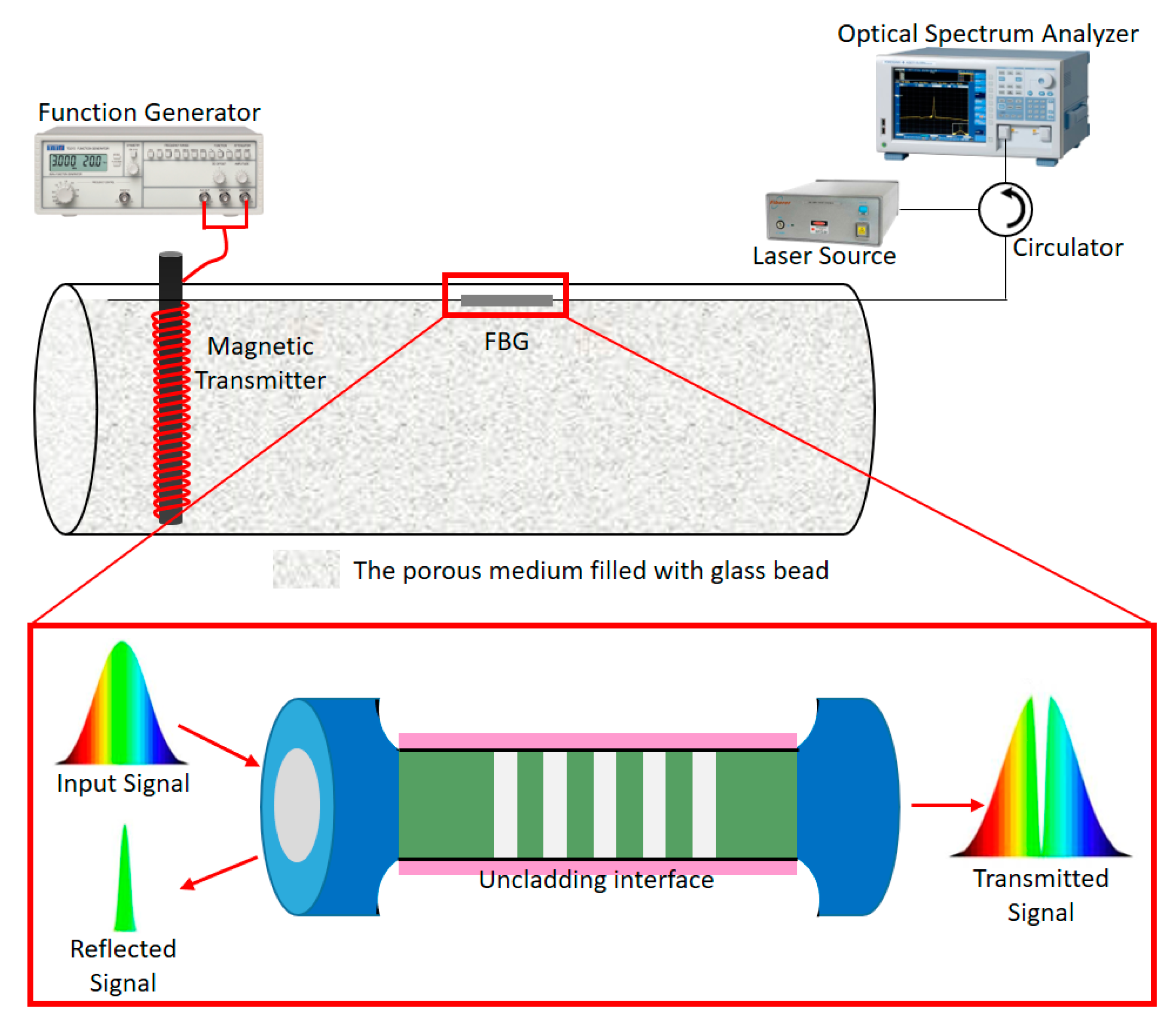
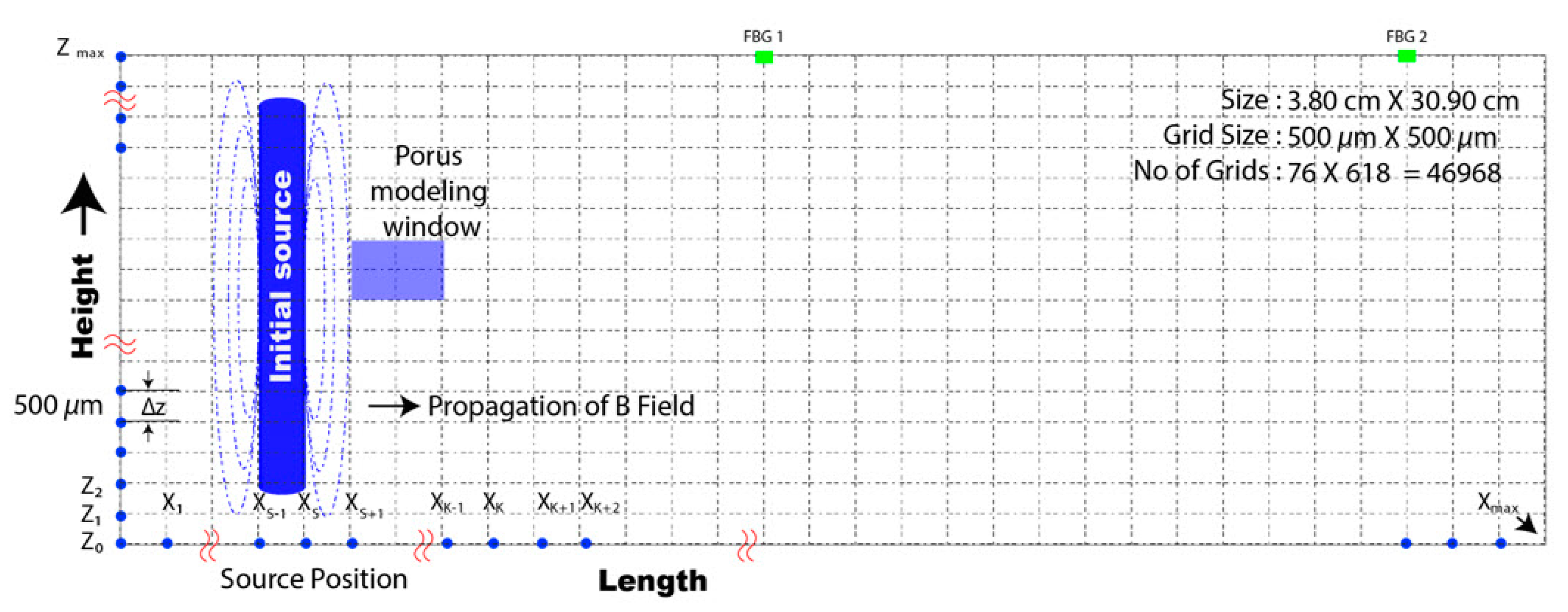
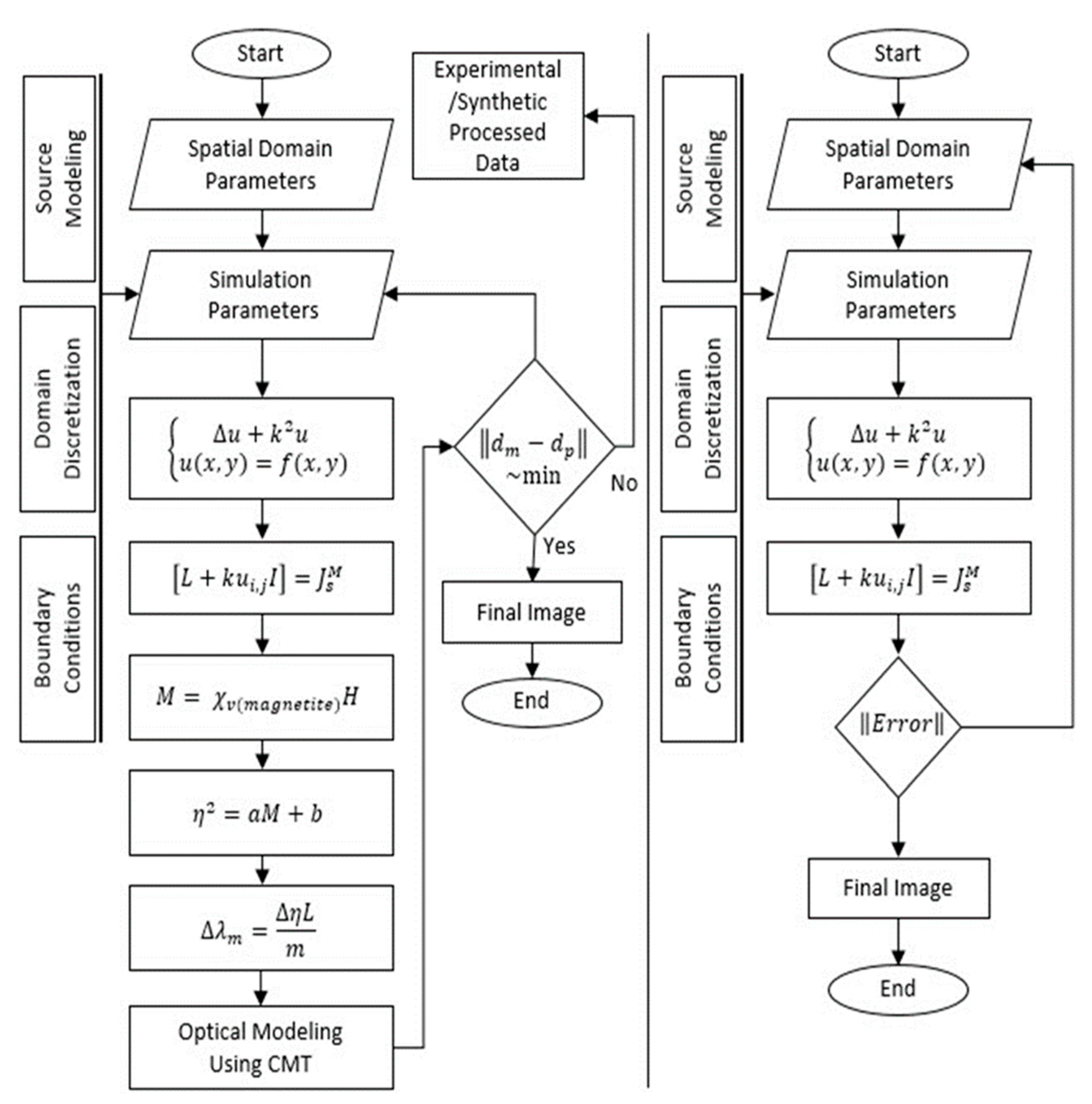
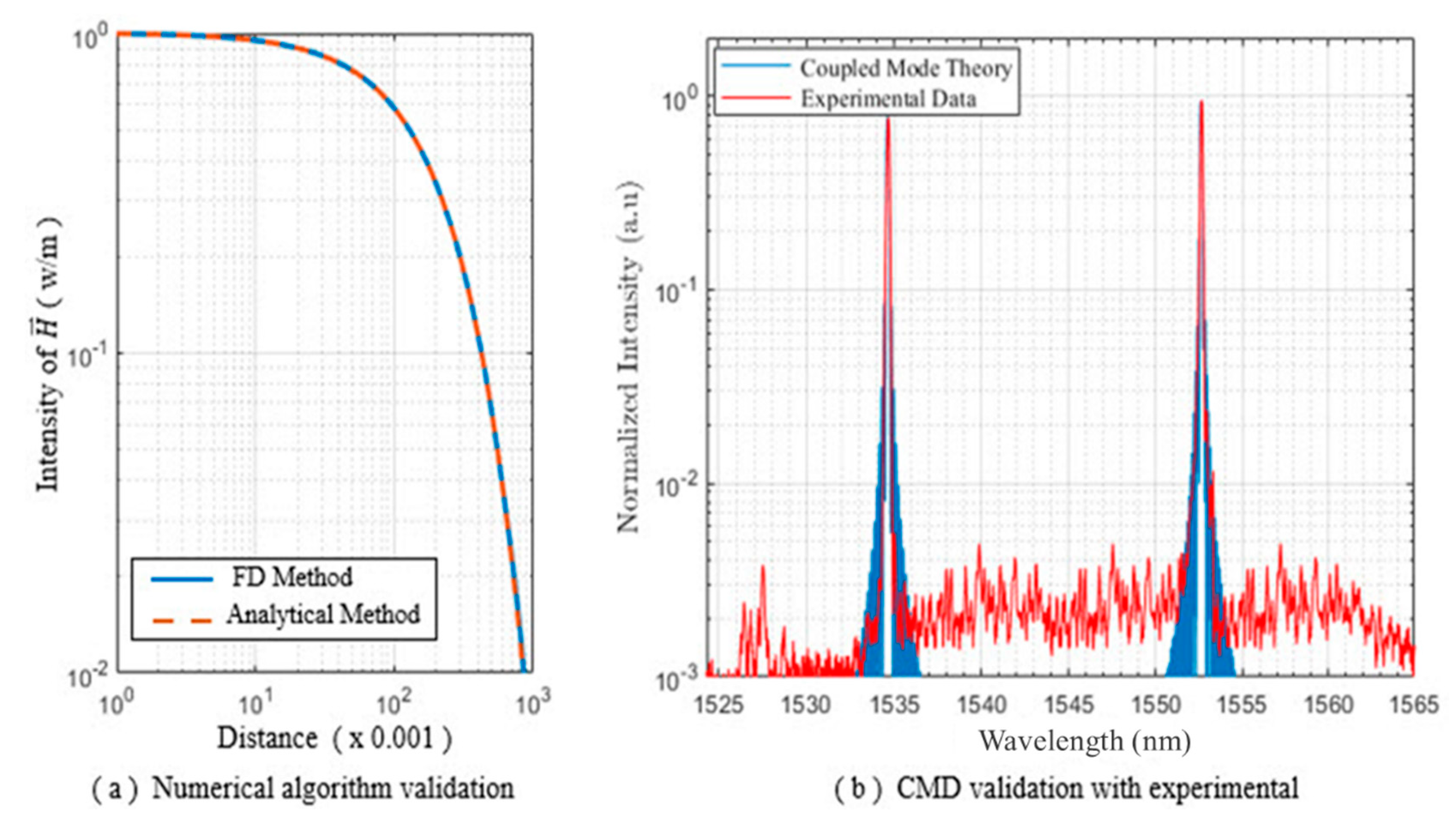
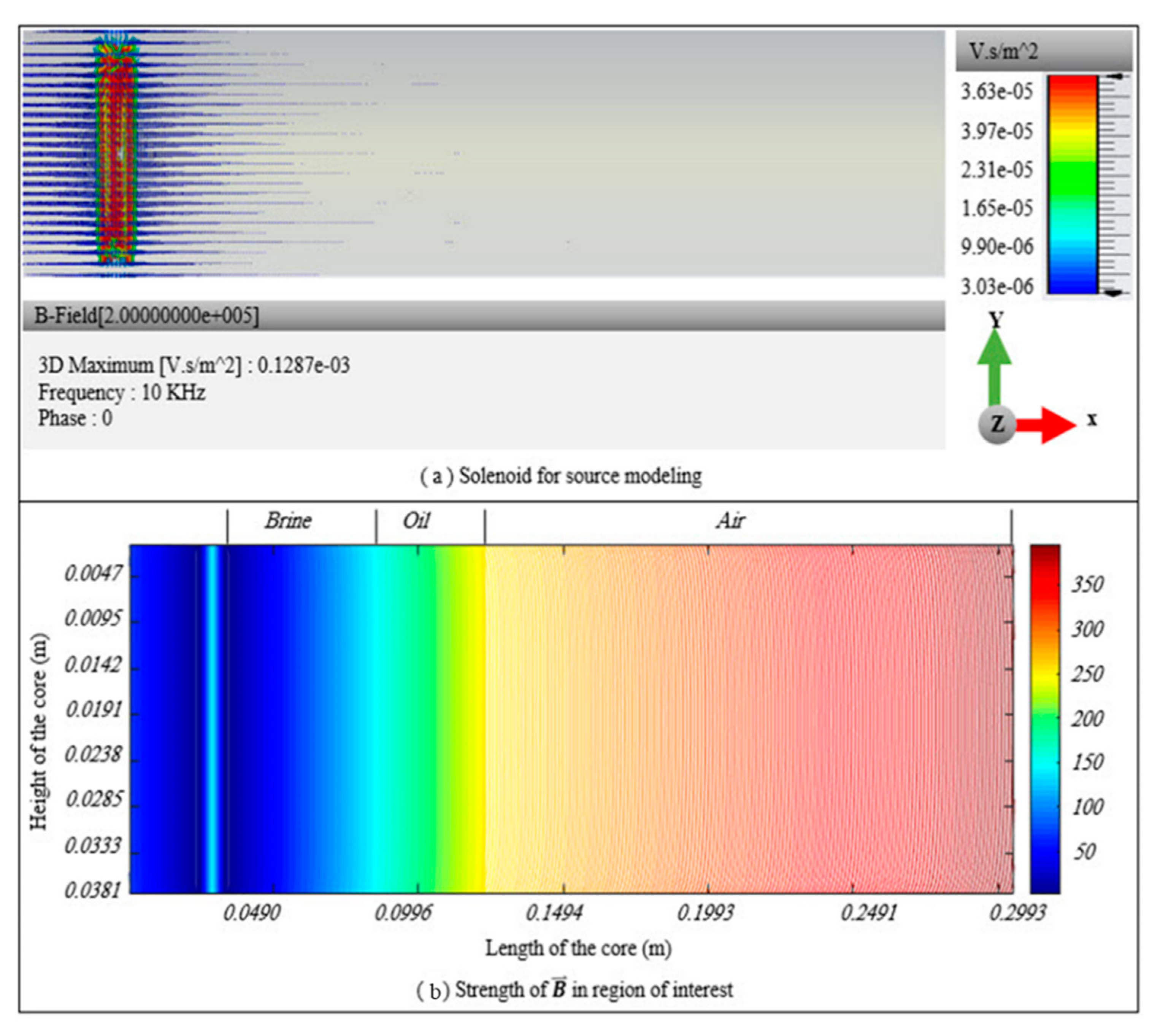

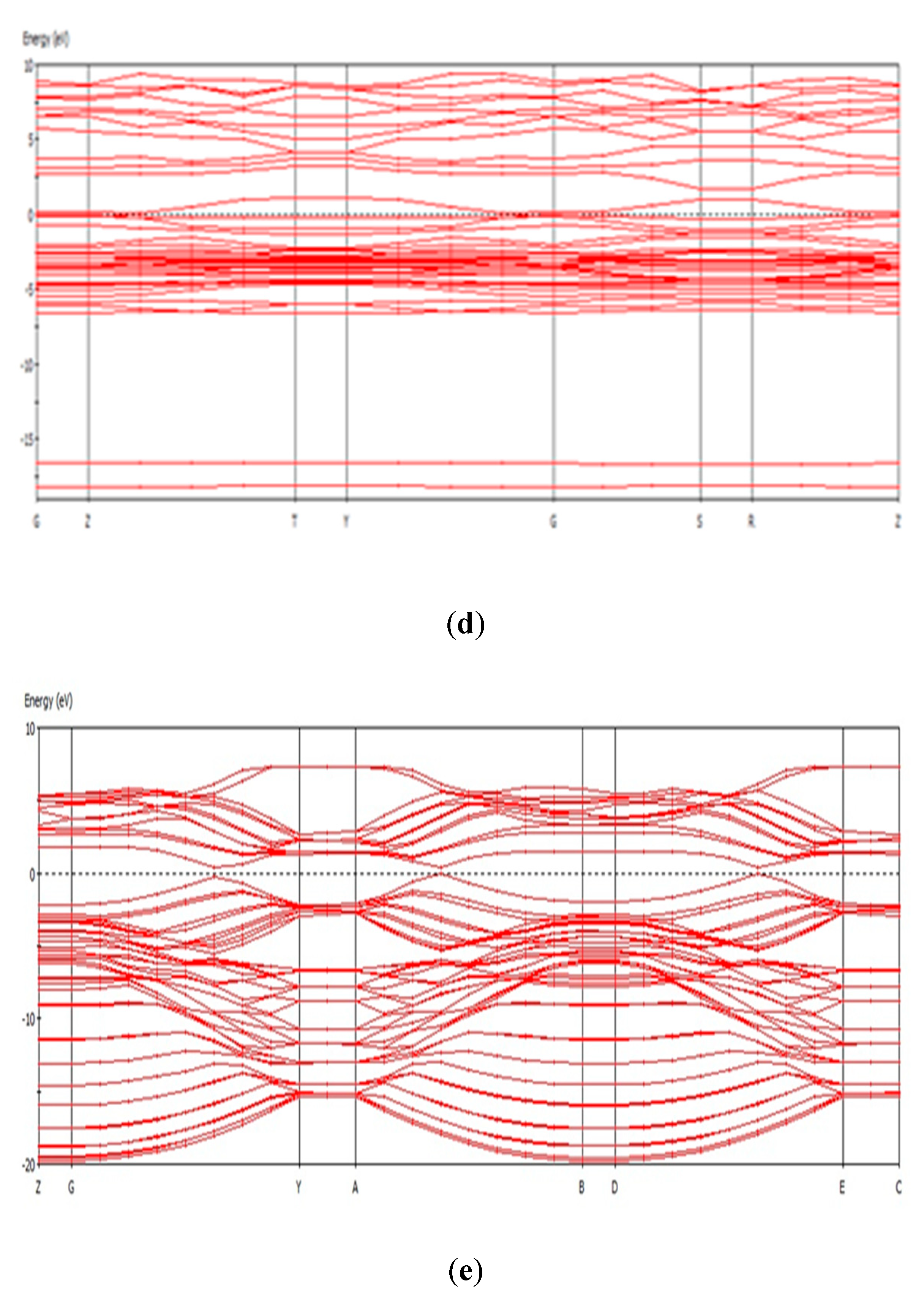
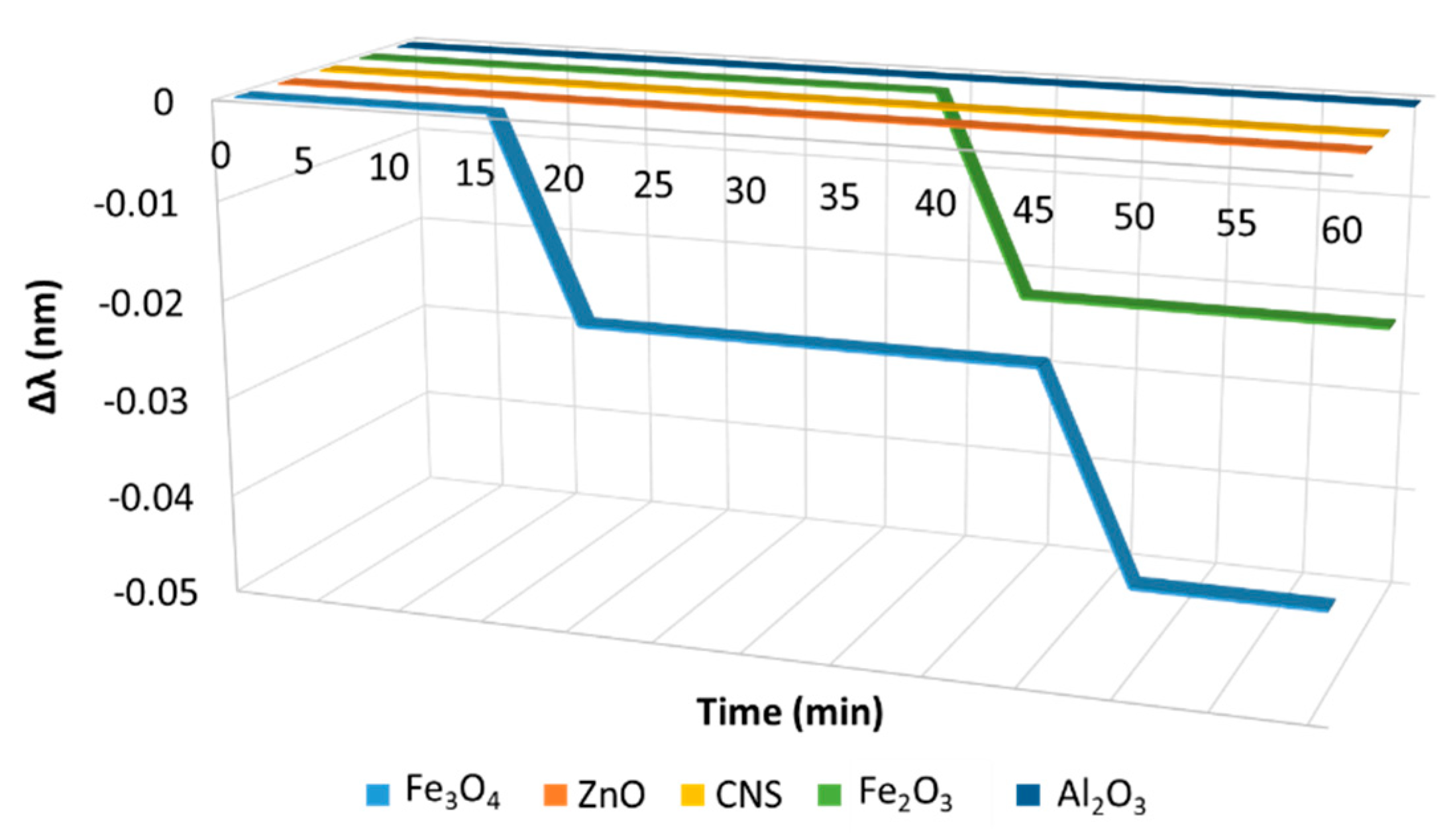


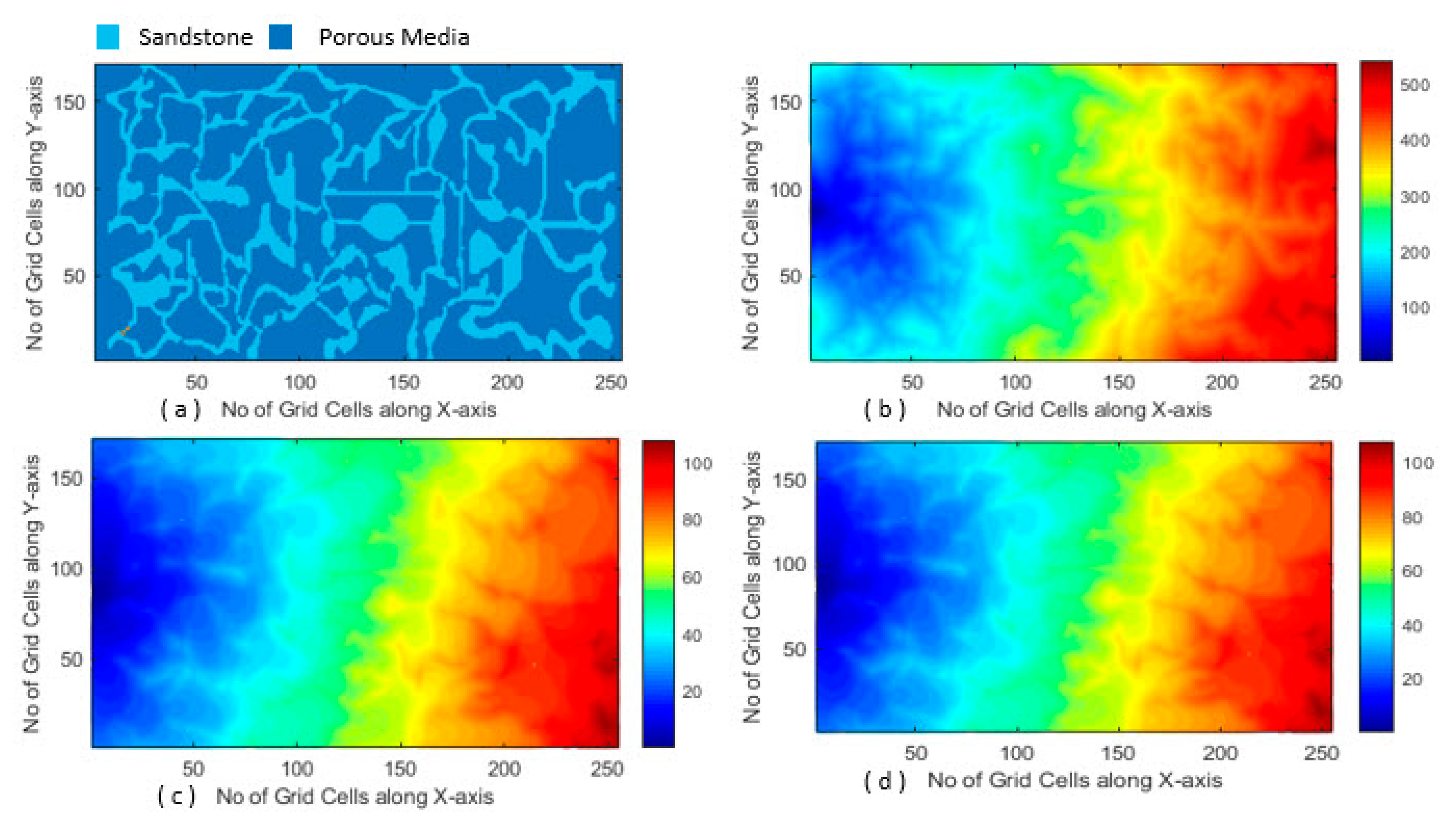
| Nanoparticle | Fe2O3 | Fe3O4 | ZnO | Al2O3 | CNS |
|---|---|---|---|---|---|
| Number of electrons | 28 | 204 | 36 | 144 | 112 |
| Net system charge | 0 | 0 | 0 | 0 | 0 |
| Number of upspins | 18 | 21 | 0 | 0 | 0 |
| Number of downspins | 10 | 21 | 18 | 72 | 56 |
| Net system spins | 8 | 0 | 18 | 72 | 56 |
| Numbers of bands | 22 | 159 | 22 | 87 | 68 |
| Band gap (eV) | 0.021 | 0.016 | 1.678 | 2.829 | 0.389 |
| Stress-autocorrelation function (SACF) | −0.011 | −0.019 | 7.597 × 10−3 | 1.339 × 10−3 | 1.931 × 10−4 |
| Parameter | Wavelength Shift (nm) | Recovery Factor (%) |
|---|---|---|
| 0 Hz | 0.01 | 55 |
| 200 kHz | 0.04 | 64 |
© 2020 by the authors. Licensee MDPI, Basel, Switzerland. This article is an open access article distributed under the terms and conditions of the Creative Commons Attribution (CC BY) license (http://creativecommons.org/licenses/by/4.0/).
Share and Cite
Yahya, N.; Mui Nyuk, C.; Ismail, A.F.; Hussain, N.; Rostami, A.; Ismail, A.; Ganeson, M.; Ali, A.M. Inversion Algorithm of Fiber Bragg Grating for Nanofluid Flooding Monitoring. Sensors 2020, 20, 1014. https://doi.org/10.3390/s20041014
Yahya N, Mui Nyuk C, Ismail AF, Hussain N, Rostami A, Ismail A, Ganeson M, Ali AM. Inversion Algorithm of Fiber Bragg Grating for Nanofluid Flooding Monitoring. Sensors. 2020; 20(4):1014. https://doi.org/10.3390/s20041014
Chicago/Turabian StyleYahya, Noorhana, Chai Mui Nyuk, Ahmad Fauzi Ismail, Nazabat Hussain, Amir Rostami, Atef Ismail, Menaka Ganeson, and Abdullah Musa Ali. 2020. "Inversion Algorithm of Fiber Bragg Grating for Nanofluid Flooding Monitoring" Sensors 20, no. 4: 1014. https://doi.org/10.3390/s20041014
APA StyleYahya, N., Mui Nyuk, C., Ismail, A. F., Hussain, N., Rostami, A., Ismail, A., Ganeson, M., & Ali, A. M. (2020). Inversion Algorithm of Fiber Bragg Grating for Nanofluid Flooding Monitoring. Sensors, 20(4), 1014. https://doi.org/10.3390/s20041014





